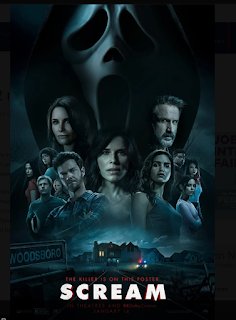Movie Conventions: Scream (2022)
In Scream, there a variety of different camera angles, movements, and shots. I noticed that the film has many still close up and extreme close up shots. These can be of inanimate objects to create suspense and leave the viewer questioning what will happen next. I also found that the film uses less movement such as tracking shots. This leaves the audience in uncertainty and they may see characters get dragged offscreen and will have no idea of their where abouts. The film uses low angle shots to make Ghostface, the antagonist, appear as a powerful, looming figure while using high angle shots over his/her victims. Additionally, there are instances of a canted angle zoom to make the characters appear to put the characters in perspective.
The costumes of the characters in Scream are usually casually clothes, such as jeans, t-shirts, and jackets, as some of the characters are high school students. The movie uses lighting to make the settings very dark and ominous. However, many of the main events in the movie occur in a household setting. Ghostface's victims act terrified upon an encounter and are stern throughout. The characters appear to be tired and dirty as the film progresses as the characters flee their assailant. The setting of the film is in the town of Woodsboro, California in residential areas.
Sound is also an important element in Scream. The score of the film creates an ominous and suspenseful tone. Other examples of the sound include the diegetic sound from the movie's universe. This can include the characters yelling as they are hunted and fight Ghostface. An example of a sound motif could be heard when Ghostface uses a voice changer to scare his/her victims when calling them on their phones.
In Scream, the editing uses many jump cuts to transition from to different locations. Eyeline matches are used to provide the audience with the views of the victims and their expressions before a jump scare.



Comments
Post a Comment